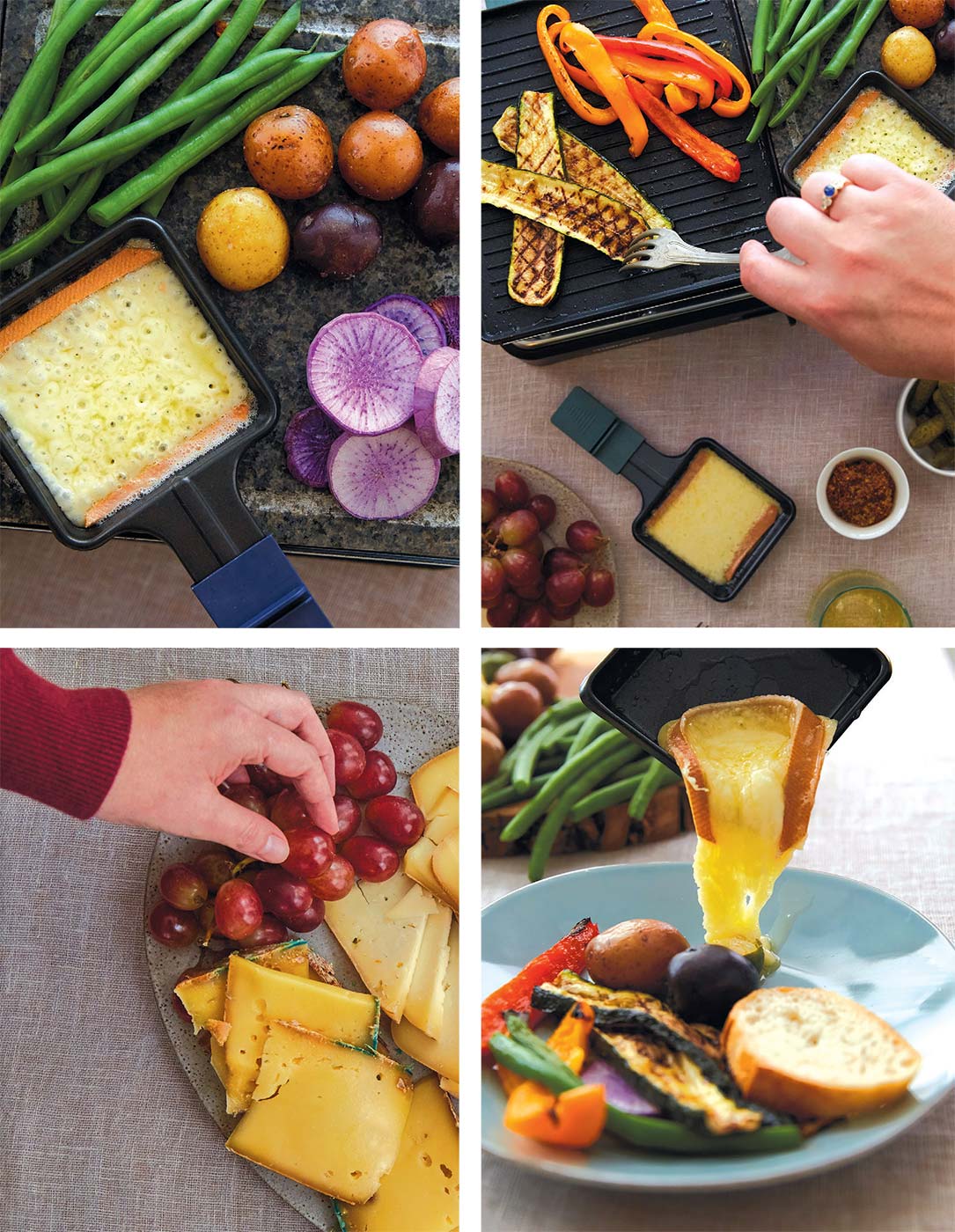How to Throw a Raclette Party

Source European cheeses and regional favorites for your melting pleasure. From front: Vermontmade Reading Raclette, cider-washed Marigold from Oley, Pa.-based Valley Milkhouse, and funky Italian Fontina d'Alpeggio.
WHEN I THINK BACK ON WINTER HOLIDAYS GROWING UP, I remember baking almond crescents and making fudge, hanging stockings on Christmas Eve and staying up late to drink sparkling apple cider and watch the ball drop on the last day of the year.
But what I remember best is the cheese.
For most of my youth, my family—two parents, two kids, two dogs—would pile into our minivan with a week’s worth of luggage and all the presents and drive from North Carolina to spend the winter holidays with my mom’s sprawling family in rural Quebec, all cornfields and cows and little villages.
On New Year’s Eve, one of my aunts would put out a bountiful spread for us visitors: crudités, nuts, pickles, olives, little sausages, heaps of cheese, French bread, potatoes—not to mention tin upon tin of cookies, bars, and brownies she’d stashed in the chest freezer throughout the year—were arranged around a contraption I never saw in the States: a raclette machine.
This tabletop marvel of Swiss engineering consisted of a central heating element with a cooking surface on top to sauté meat or veggies. Underneath, the “party grill” featured eight slots, each holding a little nonstick paddle for diners to load with their own slices of cheese. I was taught to keep close watch as each savory slab melted, bubbled and browned before pulling it off the heat and pouring that liquid gold all over a little pile of potatoes or a hunk of French bread to devour.
Though this part of Quebec doesn’t have a particular Swiss population, it does have a Swiss cheesemaker: Fromagerie Fritz Kaiser, which employed several of my cousins as teen cheesemongers at its always-packed shop just a few kilometers north of the Vermont border. None of my aunts or uncles can remember raclette being a thing there until the Kaisers started purchasing milk from area farmers and turning it into hefty wheels of Alpine-style cheese. Now, it seems that everybody in the area has their own electric “party grill” or raclette melter.
Fortunately, you don’t need a Swiss cheesemaker nearby to serve a festive holiday raclette feast. Think of it as an amped-up cheese board that’s perfect for winter weather—a modular, choose-your-own- adventure version of fondue where you never have to worry about losing your hunk of bread in the pot.
But before we melt, a little background: Raclette—which means “to scrape” in French—is both a style of cheese and a cooking technique derived from dairying traditions in both the French and Swiss Alps. In the summer months, shepherds would move their herds from the valley up to the high mountain pastures to graze. To sustain themselves, they’d pack shelf-stable foods that were easy to transport, like potatoes, along with large, nutrient-dense wheels of cheese. At mealtime, they’d set a hunk of cheese near the flames and scrape the melted cheese over cooked potatoes— and a cultural tradition on the scale of summertime backyard barbecues or Italian- American Sunday gravy was born.

Balance the richness of raclette with a variety of veggies: crisp crudite with winter radishes, hakurei turnips, and frostsweetened carrots, boiled potatoes and blanched green beans, and ready-to-grill options like zucchini and bell peppers. Top everything with cheese.
These days, we’ve swapped out the open fire for tabletop models (although, if you’ve got a working fireplace and the cash and fridge space for a half-wheel of raclette, more power to you). As with most kitchen gadgets, you can get them all at Fante’s Kitchen shop in the Italian Market.
These range from portable, brick-size “partyclette” heaters powered by tea lights for around $20—perfect to make raclette for two—to electric grills like my aunt’s, with six or eight paddles for cheese beneath and a cooking surface on top. (I got lucky with my $25 party grill, a cheapie model found in a bin of post-holiday odds and ends at Aldi, but most start at around $100). If you’re really serious about your melted cheese, you can buy an angled electric raclette burner in which to mount and melt a quarter- or half-wheel of cheese on a rotating arm for even bubbling and easy serving; these will run you a few hundred bucks.
Now, the cheese. You’ll want to anchor your selections with raclette or raclette-adjacent styles, but there’s no rulebook saying you can’t bubble a slice of Vermont cheddar or a slab of Brie under the broiler. (For some next-level raclette menus inspired by geography, check out Tia Keenan’s indispensable Melt, Stretch, & Sizzle: The Art of Cooking Cheese.) Still, I recommend leaving other styles of cheese out on their own board to be enjoyed as is, but if you or your guests decide to get a little wild as the party wears on, I certainly won’t stop you.
In terms of imported and non-local domestic styles, Di Bruno Bros. is a great first stop. Dana Pellicore, cheesemonger at their flagship store on 9th Street, often recommends Reading Raclette from Spring Brook Farm in Vermont—a semifirm raw milk wheel with notes ranging from lemon rind to barnyard funk—as an alternative to French raclettes destined for the U.S., which are typically pasteurized in order to bypass restrictions on raw milk imports.
Pellicore also recommends Swiss raw milk varieties. Raclette de Bruson is a little closer to French tomme than funky, tacky washed rind. “You get these beautiful beef bouillon notes, not quite as stinky feet as some of the French ones can get, which makes it beautiful for melting,” she says.
For a little variety of flavor, Pellicore likes selections from Swiss outfit Jumi—which makes a quality raw milk raclette, as well as balanced, subtle versions boosted with smoke, chili, saffron or black truffle. If you have an angled raclette burner that’s meant to hold a quarter-wheel, she says, Jumi’s extra-large blocks are a great option. Around the holidays, Di Bruno also stocks Fontina d’Alpeggio, a fruity, buttery take on the mild Italian melting cheese that’s made with milk from cows grazing on green grasses and tender wildflowers in those high mountain pastures.
Local cheesemakers produce some styles conducive to a raclette party, too. Pick up a hunk of Cherry Grove Farm’s Toma from their farm store in Lawrenceville, just outside Princeton, or on Wednesday afternoons at the Christ Church Farmers’ Market in Old City. Out in central Pennsylvania, Clover Creek Cheese Cellar produces their own raclette style, Tussey Mountain—named for one of the not-quite-Alps near the farm; order it from their website, or ask for it at Metropolitan Bakery’s Rittenhouse location.
Hunks of More-Beer, a creamy New Jersey take on Morbier made by Valley Shepherd, can be ordered online. For a mild yet savory alternative to funkier wheels, pick up a hunk of Valley Milkhouse’s Marigold, a farmhouse tomme washed in Frecon Farms hard cider whose lightly cooked curd gives it a silky texture and beautiful melt. (Come by Valley Milkhouse’s table at the Clark Park Farmers’ Market on Saturdays, and I just might be the one to sell you a wedge.)
Once you’ve got your melting equipment and your raw material, it’s time to accessorize. The classic Swiss preparation includes bracing mustard, tart little cornichons, and pickled pearl onions, along with must-have potatoes—but you’re really only limited by your imagination.
The important thing about raclette, after all, is that it’s a group effort, a convening of friends around the warm glow and heady aroma of melted cheese in the darkest weeks of winter. I can’t think of a better party than that.












